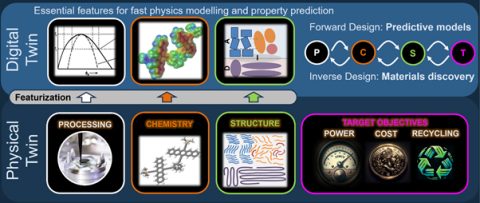Advancing PV Research: A Digital Twin Perspective on Material Science
On sunny days, up to 60% of the electricity in Germany is produced by photovoltaics (PV). This is good news to fight climate change, but also entails problems such as the land use by large PV fields or the question of recycling. Addressing these issues requires to devise entirely new materials for photovoltaic applications, from the molecular design all the way to the integrated solar cell. To achieve this, we must be able to quickly sort through many different molecules, processing conditions, layer stacks and operating conditions. This spans up a formidable experimental space which must be navigated efficiently by rejecting redundancy and by using physics relations. This is exactly the realm of a Digital Twin. An interdisciplinary team of researchers at FAU, involving PV materials experts, mathematicians, engineers, and AI developers, is proposing a layout of a Digital Twin for PV materials. Using a digital Twin, we can learn more about the physics of the materials from simpler and faster experiments. This is accomplished by a process called “featurization”. Knowing the essential features can show us the path from the desired performance of a solar cell to an unknown molecular structure, that is, to accelerated materials discovery

